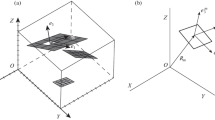Abstract
The application of the displacement discontinuity numerical technique to the solution of some problems of fracture mechanics is demonstrated in the hypothesis of homogeneous and elastic material. The fracture is supposed to be free from traction and is represented by a set of constant displacement discontinuity elements, except for two parabolic elements, located at each crack tip, in order to simulate the singularity of the solution near the crack tips. On the basis of the stress and displacement field determined by the displacement discontinuity method, the stress intensity factors for mode I and II are computed according to the method of the displacements. Three examples are provided to verify the validity of the formulation.
Sommario
Lo scopo del presente lavore è di illustrare l'applicazione del metodo numerico della Displacement Discontinuity alla soluzione di alcuni problemi di meccanica della frattura, nell'ipotesi di materiale omogeneo ed elastico. La frattura è supposta aperta ed è rappresentata da una linea di elementi a discontinuità di spostamento costante, con l'eccezione di due speciali elementi parabolici, ubicati agli apici, al fine di simulare la singolarita' del campo tensionale. Sulla base del campo degli sforzi e degli spostamenti cosi determinati, vengono ricavati i fattori di concentrazione degli sforzi in modo I e II mediante il metodo degli spostamenti. Vengono inoltre riportati tre esempi di calcolo, effettuati al fine di verificare la validità del procedimento proposto.
Similar content being viewed by others
References
Barsoum, R. S., ‘On the use of isoparametric finite elements in linear fracture mechanics’, Int. J. Num. Meth. in Eng., 10, (1976) 25–38.
Cruse, T. A., ‘Boundary-integral equation fracture mechanics analysis’, Boundary-Integral Equation Method: Computational Applications in Applied Mechanics, ASME Appl. Mech. Sym. Series, AMD, 11 1975 31–48.
Cruse, T. A., ‘Two-dimensional BEM fracture mechanics analysis’, Appl. Math. Modelling, 2, (1978) 288–293.
Cruse, T. A. and Wilson, R. B., ‘Advanced applications of boundaryintegral equation methods’, Nucl. Eng. Design, 46 (1978) 2234–2244.
Cruse, T. A., Boundary Element Analysis in Computational Fracture Mechanics, Kluwer Academic Publishers, Dordrecht, 1987.
Carpinteri, A., Valente, S., ‘Size-scale transition from ductile to brittle failure: a dimensional analysis approach’, CNRS-NSF Workshop on Strain Localization and Size Effect due to Cracking and Damage, Cachan, 1988, pp. 422–490.
Carpinteri, A., Valente, S. and Bocca, P., ‘Mixed mode cohesive crack propagation’, Seventh International Conference on Fracture, Houston, 1988, pp. 2243–2258.
Brandford, G. E., Ingraffea, A. R. and Ligget, J. A., ‘Two-dimensional stress intensity factor computations using the boundary element method’, Int. J. Num. Meth. in Eng., 17 (1981) 387–404.
Crouch, S. L. and Starfield, A. M., Boundary Element Methods in Solid Mechanics, George Allen and Unwin Publishers, London, 1983.
Crouch, S. L., ‘Solution of plane elastic problem by the displacements discontinuity method’, Int. J. Num. Meth. in Eng., 10 (1976) 301–343.
Carpinteri, A., Mechanical Damage and Crack Growth in Concrete, Martinus Nijhoff Publishers, Dordrecht, 1986.
Monegato, G., Calcolo numerico, Levrotto & Bella, Torino, 1985.
Tweed J. and Rooke, D. P., The distribution of stress near the tip of a radial crack at the edge of a circular hole’, Int. J. Eng. Sci., II 1973.
Murakami, Y., Stress Intensity Factors Handbook, Pergamon Press, Oxford 1987.
Author information
Authors and Affiliations
Rights and permissions
About this article
Cite this article
Scavia, C. The displacement discontinuity method in the analysis of open cracks. Meccanica 26, 27–32 (1991). https://doi.org/10.1007/BF00517722
Received:
Accepted:
Issue Date:
DOI: https://doi.org/10.1007/BF00517722




